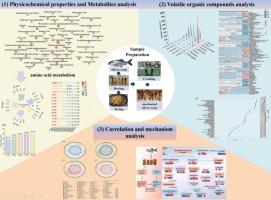Dynamic changes in flavor characteristics of marinated silver carp during marinating: Insight from amino acid metabolic pathways
IF 8
1区 农林科学
Q1 FOOD SCIENCE & TECHNOLOGY
引用次数: 0
Abstract
Marinated silver carp is highly favored for its distinctive flavor profile, but the role of amino acid metabolism in the formation of characteristic flavors during marinating remains unclear. This study systematically investigated the formation and evolution mechanism of flavor during the marinating of silver carp through physicochemical analysis, microstructural characterization, flavor substance identification and metabolomic analysis. The marinating process promoted moisture migration and myofibril coarsening, leading to a progressive yellowing of color and a decline in hardness and chewiness of the marinated silver carp as cooking time increased. Although the total FAA content continued to decrease, the EAA/TAA ratio at both 90 min and 120 min met the ideal protein pattern recommended by FAO/WHO. Additionally, the non-targeted metabolome identified 1591 differential metabolites, of which 54 were significantly associated with amino acid metabolism. KEGG pathway analysis showed that the amino acid metabolic pathway (such as histidine metabolism, phenylalanine metabolism, and lysine biosynthesis) was dominant and its dynamic changes reflected the stage-specific characteristics of protein degradation. The 47 key compounds (VIP>1) identified by GC–MS showed significant positive correlation (r > 0.7, P < 0.05) with most organic acids and significant negative correlation (r < −0.7, P < 0.05) with most amino acids and their derivatives, highlighting the critical role of amino acid metabolism in flavor formation during the marinating of silver carp. These findings provide a scientific basis for the targeted modulation of flavor in marinated silver carp, offering insights for optimizing processing parameters to enhance sensory quality.

腌制鲢鱼风味特征的动态变化:氨基酸代谢途径的启示
腌制鲢鱼因其独特的风味而备受青睐,但在腌制过程中氨基酸代谢在风味形成中的作用尚不清楚。本研究通过理化分析、微观结构表征、风味物质鉴定和代谢组学分析,系统探讨了鲢鱼腌制过程中风味物质的形成与演化机制。腌制过程促进了水分的迁移和肌原纤维的粗化,随着腌制时间的延长,鲢鱼的颜色逐渐变黄,硬度和嚼劲下降。尽管总FAA含量持续下降,但90 min和120 min时的EAA/TAA比值均满足FAO/WHO推荐的理想蛋白质模式。此外,非靶向代谢组鉴定出1591种差异代谢物,其中54种与氨基酸代谢显著相关。KEGG途径分析表明,氨基酸代谢途径(如组氨酸代谢、苯丙氨酸代谢和赖氨酸生物合成)占主导地位,其动态变化反映了蛋白质降解的阶段性特征。GC-MS鉴定的47个关键化合物(VIP>1)与大多数有机酸呈显著正相关(r > 0.7, P < 0.05),与大多数氨基酸及其衍生物呈显著负相关(r < - 0.7, P < 0.05),说明氨基酸代谢在鲢鱼腌制过程中风味形成的关键作用。研究结果为鲢鱼风味的定向调控提供了科学依据,为优化加工工艺参数提高感官品质提供了参考。
本文章由计算机程序翻译,如有差异,请以英文原文为准。
求助全文
约1分钟内获得全文
求助全文
来源期刊

Food Research International
工程技术-食品科技
CiteScore
12.50
自引率
7.40%
发文量
1183
审稿时长
79 days
期刊介绍:
Food Research International serves as a rapid dissemination platform for significant and impactful research in food science, technology, engineering, and nutrition. The journal focuses on publishing novel, high-quality, and high-impact review papers, original research papers, and letters to the editors across various disciplines in the science and technology of food. Additionally, it follows a policy of publishing special issues on topical and emergent subjects in food research or related areas. Selected, peer-reviewed papers from scientific meetings, workshops, and conferences on the science, technology, and engineering of foods are also featured in special issues.
 求助内容:
求助内容: 应助结果提醒方式:
应助结果提醒方式:


